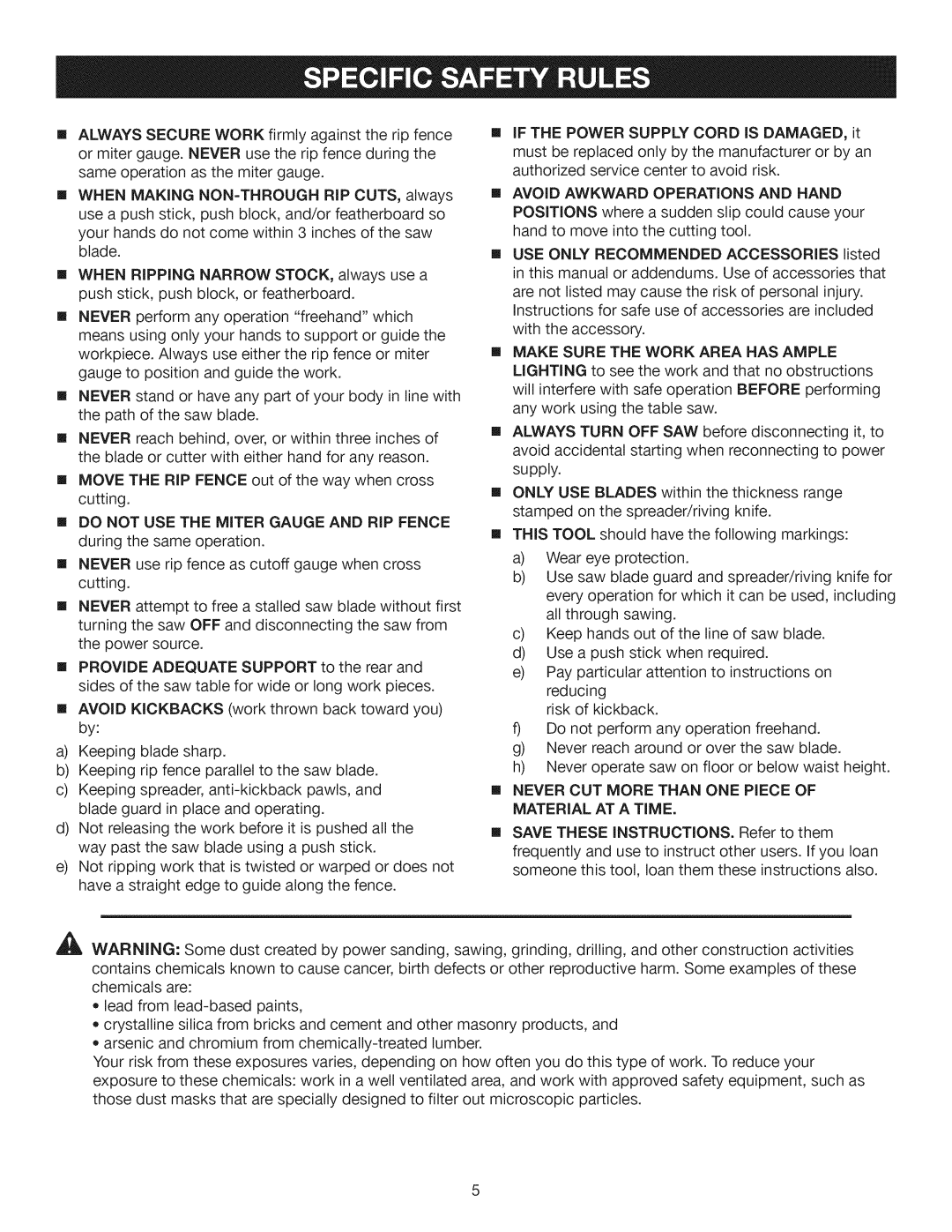
[] ALWAYSSECUREWORKfirmlyagainsttheripfence
ormitergauge.NEVERusetheripfenceduringthe
sameoperationasthemitergauge.
[] WHENMAKING NON=THROUGH RiP CUTS, always use a push stick, push block, and/or featherboard so your hands do not come within 3 inches of the saw blade.
[] WHEN RIPPING NARROW STOCK, always use a push stick, push block, or featherboard.
[] NEVER perform any operation "freehand" which means using only your hands to support or guide the workpiece. Always use either the rip fence or miter gauge to position and guide the work.
[] NEVER stand or have any part of your body in line with the path of the saw blade.
[] NEVER reach behind, over, or within three inches of the blade or cutter with either hand for any reason.
[] MOVE THE RIP FENCE out of the way when cross cutting.
[] DO NOT USE THE MITER GAUGE AND RIP FENCE during the same operation.
[] NEVER use rip fence as cutoff gauge when cross cutting.
[] NEVER attempt to free a stalled saw blade without first turning the saw OFF and disconnecting the saw from the power source.
[] PROVIDE ADEQUATE SUPPORT to the rear and sides of the saw table for wide or long work pieces.
[] AVOID KICKBACKS (work thrown back toward you) by:
a)Keeping blade sharp.
b)Keeping rip fence parallel to the saw blade.
c)Keeping spreader,
d)Not releasing the work before it is pushed all the way past the saw blade using a push stick.
e)Not ripping work that is twisted or warped or does not have a straight edge to guide along the fence.
[] IF THE POWER SUPPLY CORD IS DAMAGED, it must be replaced only by the manufacturer or by an authorized service center to avoid risk.
[] AVOID AWKWARD OPERATIONS AND HAND POSiTiONS where a sudden slip could cause your hand to move into the cutting tool.
[] USE ONLY RECOMMENDED ACCESSORIES listed in this manual or addendums. Use of accessories that are not listed may cause the risk of personal injury.
Instructions for safe use of accessories are included with the accessory.
[] MAKE SURE THE WORK AREA HAS AMPLE LIGHTING to see the work and that no obstructions will interfere with safe operation BEFORE performing any work using the table saw.
[] ALWAYS TURN OFF SAW before disconnecting it, to avoid accidental starting when reconnecting to power supply.
[] ONLY USE BLADES within the thickness range stamped on the spreader/riving knife.
[] THiS TOOL should have the following markings:
a)Wear eye protection.
b)Use saw blade guard and spreader/riving knife for every operation for which it can be used, including
all through sawing.
c)Keep hands out of the line of saw blade.
d)Use a push stick when required.
e)Pay particular attention to instructions on
reducing
risk of kickback.
f)Do not perform any operation freehand.
g)Never reach around or over the saw blade.
h)Never operate saw on floor or below waist height.
[] NEVER CUT MORE THAN ONE PIECE OF
MATERIAL AT A TIME.
[] SAVE THESE INSTRUCTIONS. Refer to them
frequently and use to instruct other users. If you loan someone this tool, loan them these instructions also.
_L WARNING: Some dust created by power sanding, sawing, grinding, drilling, and other construction activities
contains chemicals known to cause cancer, birth defects or other reproductive harm. Some examples of these chemicals are:
•lead from
crystalline silica from bricks and cement and other masonry products, and arsenic and chromium from
Your risk from these exposures varies, depending on how often you do this type of work. To reduce your exposure to these chemicals: work in a well ventilated area, and work with approved safety equipment, such as those dust masks that are specially designed to filter out microscopic particles.
